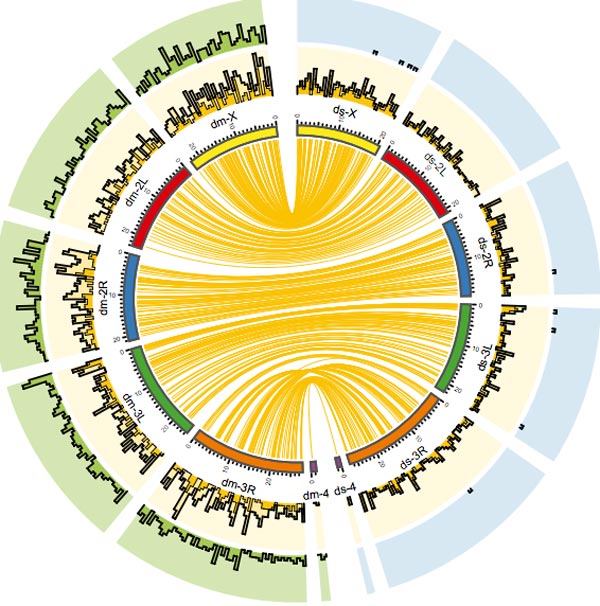New software helps to find out why “jumping genes” are activated

Using the new tool PoPoolationTE2 allows for calculating the frequency of transposable elements in Pool-Seq sequencing reactions. (Figure: Robert Kofler/Vetmeduni Vienna)
The genome is not a fixed code but flexible. It allows changes in the genes. Transposons, however, so-called jumping genes, interpret this flexibility in a much freer way than “normal” genes. They reproduce in the genome and chose their position themselves. Transposons can also jump into a gene and render it inoperative. Thus, they are an important distinguishing mark for the development of different organisms.
Unclear what triggers transposon activity
However, it is still unclear how jumping genes developed and what influences their activity. “In order to find out how, for instance, climate zones influence activity, we must be able to compare the frequency of transposons in different populations – in different groups of individuals,” explained bioinformatician Robert Kofler from the Institute of Population Genetics at the University of Veterinary Medicine, Vienna. But this frequency has not yet been determined precisely.
New software for a low-priced method
Transposons are detected by DNA sequencing. But this detection cannot be carried out for every single member of a population. “At the moment, this would go beyond the available resources regarding finance and amount of work. The only – and much cheaper – option is to analyse an entire population in one reaction,” explained last author Christian Schlötterer. This method, which he has established using the example of fruit flies, is called Pool-Seq. It is also routinely applied to detect transposons.
Existing analysis programmes, however, could not provide a precise result in this case. So far, each analysis has been biased by different factors such as the sequencing depth and the distance between paired reads.
For this purpose, Kofler developed the new software PoPoolationTE2. “If we sequence entire populations, each reaction provides a different result. The number of mixed individuals is always the same, but the single individuals differ,” explained Kofler. Furthermore, technical differences in the sample processing, among others, have influenced the analysis so far. PoPoolationTE2 is not affected by these factors. Thus, questions about the activity of transposons can be answered precisely for Pool-Seq reactions.
Interesting for cancer research
“The unbiased detection of transposon abundance enables a low-price comparison of populations from, for instance, different climate zones. In a next step, we can find out if a transposon is very active in a particular climate zone,” said Kofler. In principle, the bioinformatician has developed this new software for Pool-Seq. But as this method is also applied in medical research and diagnosis, the programme is also interesting for cancer research or the detection of neurological changes since transposons also occur in the brain.
Lab experiments confirm influencing factors
Lab experiments can indicate the factors influencing transposons. Last author Schlötterer explained these factors referring to an experiment with fruit flies: “We breed a hundred generations per population and expose them to different stimuli. We sequence at every tenth generation and determine if a stimulus has influenced the activity of the transposons. Thus, we can describe the activity of transposons in fast motion, so to say.” If the abundance is low, the scientists assume that the transposons are only starting to become more frequent. If a transposon reproduces very quickly in a particular population, this is called an invasion. If a jumping gene is detected in an entire population and not in another one, it could have been positively selected.
Service:
The article “PoPoolationTE2: comparative population genomics of transposable elements using Pool-Seq“ by Robert Kofler, Daniel Gómez-Sánchez and Christian Schlötterer was published in the journal Molecular Biology and Evolution.
http://mbe.oxfordjournals.org/content/early/2016/07/22/molbev.msw137.abstract
About the University of Veterinary Medicine, Vienna
The University of Veterinary Medicine, Vienna in Austria is one of the leading academic and research institutions in the field of Veterinary Sciences in Europe. About 1,300 employees and 2,300 students work on the campus in the north of Vienna which also houses five university clinics and various research sites. Outside of Vienna the university operates Teaching and Research Farms. http://www.vetmeduni.ac.at
Scientific Contact:
Robert Kofler
Institute of Population Genetics
University of Veterinary Medicine Vienna (Vetmeduni Vienna)
T +43 1 25077-4333
robert.kofler@vetmeduni.ac.at
Released by:
Georg Mair
Science Communication / Corporate Communications
University of Veterinary Medicine Vienna (Vetmeduni Vienna)
T +43 1 25077-1165
georg.mair@vetmeduni.ac.at
http://www.vetmeduni.ac.at/en/infoservice/presseinformation/presseinformationen-…
Media Contact
All latest news from the category: Life Sciences and Chemistry
Articles and reports from the Life Sciences and chemistry area deal with applied and basic research into modern biology, chemistry and human medicine.
Valuable information can be found on a range of life sciences fields including bacteriology, biochemistry, bionics, bioinformatics, biophysics, biotechnology, genetics, geobotany, human biology, marine biology, microbiology, molecular biology, cellular biology, zoology, bioinorganic chemistry, microchemistry and environmental chemistry.
Newest articles

Silicon Carbide Innovation Alliance to drive industrial-scale semiconductor work
Known for its ability to withstand extreme environments and high voltages, silicon carbide (SiC) is a semiconducting material made up of silicon and carbon atoms arranged into crystals that is…

New SPECT/CT technique shows impressive biomarker identification
…offers increased access for prostate cancer patients. A novel SPECT/CT acquisition method can accurately detect radiopharmaceutical biodistribution in a convenient manner for prostate cancer patients, opening the door for more…

How 3D printers can give robots a soft touch
Soft skin coverings and touch sensors have emerged as a promising feature for robots that are both safer and more intuitive for human interaction, but they are expensive and difficult…





















